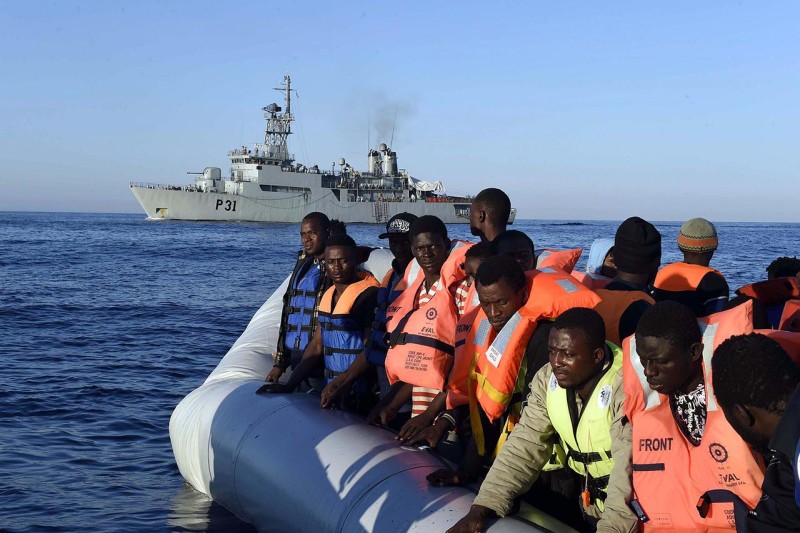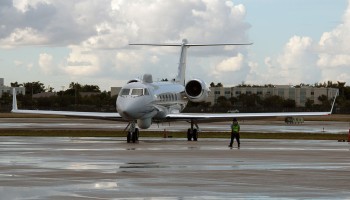Said was enjoying the February sunset and drinking tea with his family in his small Somalian village when the local imam approached his hut with two guards with an instruction: The 22-year-old was to join the Salafist jihadist group al-Shabab as soon as tomorrow.
It was almost a death sentence. “They just take you to the front and give you a gun. If you don’t shoot, you die,” Said explained.
After the imam left, the family sat speechless. Said’s mother was the first to say it: “You have to leave the country! Tonight!”
Two years later, Said is safe in Belgium but the agonizing ten-month trip took a toll. He paid US$ 3,000 to get here but also to be beaten, forced into slave labor, and confronted with rape, torture, and death.
According to the World Food Program, 73 percent of Somalis live on under $2 per day. If Said’s mother had a job, she would have had to work for over four years to collect such a large sum.
And needless to say, though Said is now out of harm’s way, his family is not. To ensure their safety back in Somalia, he asked reporters not to disclose his full name.
“The journey we take as refugees destroys us physically and morally,” he told OCCRP.
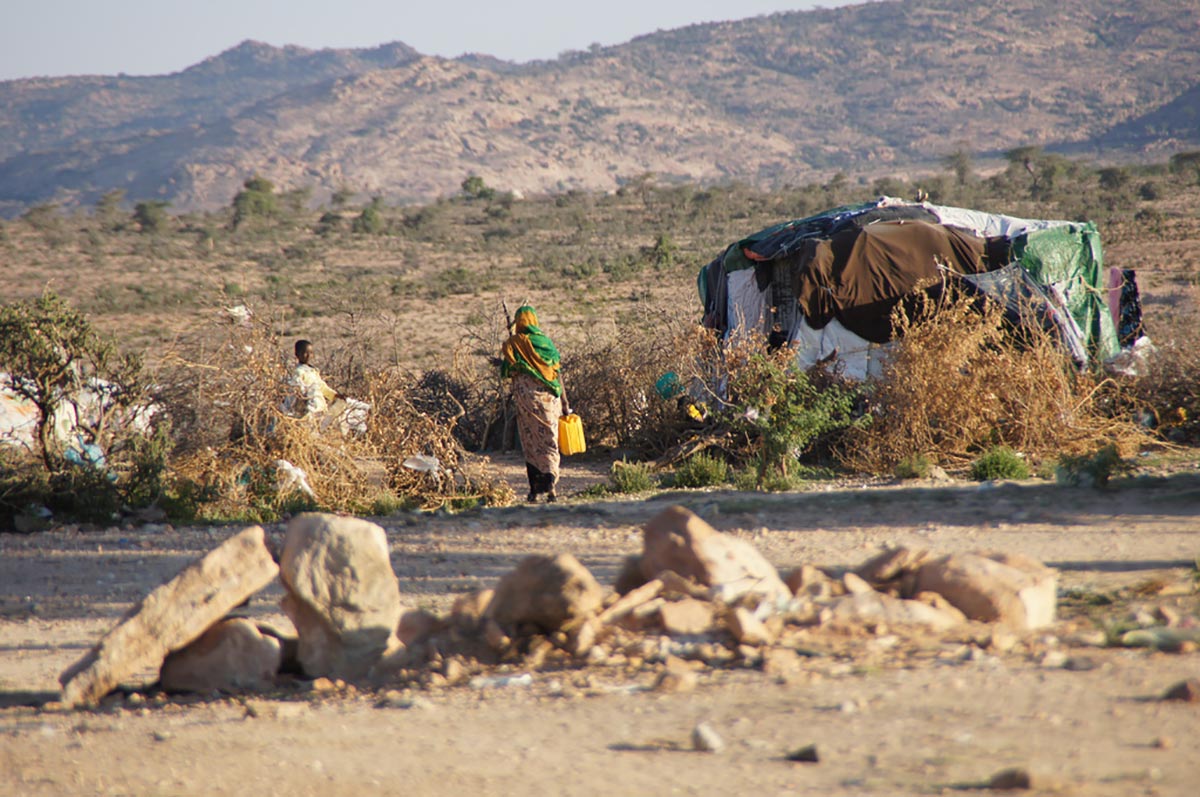 Somalia countryside landscape by ‘Feed my Hungry Children’, Flickr (CC BY 2.0)
Somalia countryside landscape by ‘Feed my Hungry Children’, Flickr (CC BY 2.0)
Nowhere to Go
Said is from a small village in the semiarid grasslands of southern Somalia, where goats wander looking for grass and water between scattered acacias and traditional huts made of branches, cloth, and hides. Most of its inhabitants make money selling goat milk and wood to merchants who bring their products to the port city of Kismayo, some dozen miles to the east.
Said was nine when his father left village, never to return, putting him in charge of providing for his family. He chopped trees and shrubs with his machete, sold the wood to buy tea, brewed the tea, and sold it to villagers. While they drank, Said shined their shoes.
Al-Shabab, which means “The Youth,” recruits young men from the countryside to fight the Somali government and the African Union Mission in Somalia (AMISOM).
The group describes its war as a jihad against the "enemies of Islam." According to the Council on Foreign Relations, al-Shabab is affiliated with al-Qaeda and has between 7,000 and 9,000 members. In 2006, its fighters started taking over large areas of chaotic and war-torn Somalia, which has had fourteen governments between 1991 and 2010.
“Where I’m from, al-Shabab is really big,” Said said. “They use our village to train recruits and almost everyone I know is connected to them.”
The Shabaab’s fundamentalist precepts control every aspect of village life.
“You have to go to every prayer and you can’t cut your hair,” Said said. “They’ll kill you if they catch you drinking or chewing khat. You have to wear white clothes and a taqiyah, and you’re forced to grow a beard. They wouldn’t even allow me to hold hands with my kid sister because of their rules about men and women.”
The evening before the imam’s visit, Said had been cutting trees with his friends. They chewed khat, a plant with amphetamine-like effects, so they could work longer. Caught in a haze, they lost track of time and were late for prayer. By the time they got to the mosque, the two guards at the entrance said they were too late and couldn’t go inside.
It was the same two guards who came to the family hut with the imam later that night.
At prayer, the community leaders take note of who shows up, when they arrive, and where they sit. Because he was late, Said had caught the attention of the mosque’s imam, Abu Sidow, who had taught him the Quran. Said believes that’s why he was picked for recruitment.
Said credits his mother with teaching him to be critical of al-Shabab’s recruitment efforts. The group tells people that “UNICEF and Red Cross give you poisoned food” and that the Somali government will “rape your families,” Said explained.
Some Somalis believe that al-Shabab contaminates the food they dole out with black magic, which allows them to control people’s minds.
“They brainwash you and make you blow yourself up, which I don’t understand,” he said. “I think it must be black magic. My mom told me that I don’t have to believe them, those killers.”
Leaving Somalia
In 2016, almost one fifth of Somalia’s population lived abroad, according to estimates by the United Nations and the PEW Research Center.
For many Somalis, leaving the country is the only way to escape al-Shabab, drought-induced famine, and violent clannism.
“The first thing Somalis want to know is which clan you belong to,” Said said.
Somalia’s clan system is called “four point five,” he said. Four big clans control most of the country and have the most seats in parliament. The many other small clans together are only worth half of one of the big ones — the “point five.”
Said’s family belongs to a marginalized clan called the Ajuran, which can’t protect him from the other clans — or from al-Shabab.
Now it was time for Said to join his compatriots in the diaspora.
After the imam’s visit, Said’s mother contacted a friend of the family named Ahmed, who transported wood and milk in his pickup truck.
Nicknamed “the khat-eating camel,” Ahmed regularly bought the wood Said collected and sold it to charcoal producers in Kismayo. Perhaps Said could hide in his truck on the way to the port city, his mother suggested.
Transporting Said would be dangerous. Ahmed would have to hide him not only from al-Shabab, but also from soldiers of the African Union Mission to Somalia, who might accuse him of smuggling an al-Shabab member.
They agreed that Said would stand on the bed of Ahmed’s truck, hidden between the crates and on the lookout for al-Shabab and the African Union soldiers.
When they saw checkpoints or troops, Said would jump out and hide in the bushes. Once Ahmed had passed the checkpoint, Said would climb back in.
The ploy worked, but the journey had just begun.
After reaching Kismayo, Said crossed into Ethiopia, where soldiers stopped and searched another truck that was taking him across the country. Luckily, he had 50 Ethiopian Birr (about two dollars), which he paid just to have them send him back to Kismayo instead of arresting him or worse.
He called his mom, who didn’t have good news. “‘Al-Shabab are looking for you,’ she told me ‘They already know your name, why you left, and where you went,’” Said said. “I couldn’t go back.”
Said’s mother asked for advice from an acquaintance named Haxwo, who had also left Somalia and made it to Belgium. Haxwo advised her that Said should head for Kenya next.
“I paid a fisherman to take me to Mombasa on his boat. I disguised myself as a fisherman and kept quiet when we came across others,” Said said. “I stayed in Mombasa for four months, serving chips in a restaurant. That’s where I learned English.”
But it wasn’t an easy stay. Said was a frequent target for corrupt police officials, since he was in the city illegally and spoke no Swahili. He was arrested almost every day, and each time he had to spend some of the little money he had made to pay his way out.
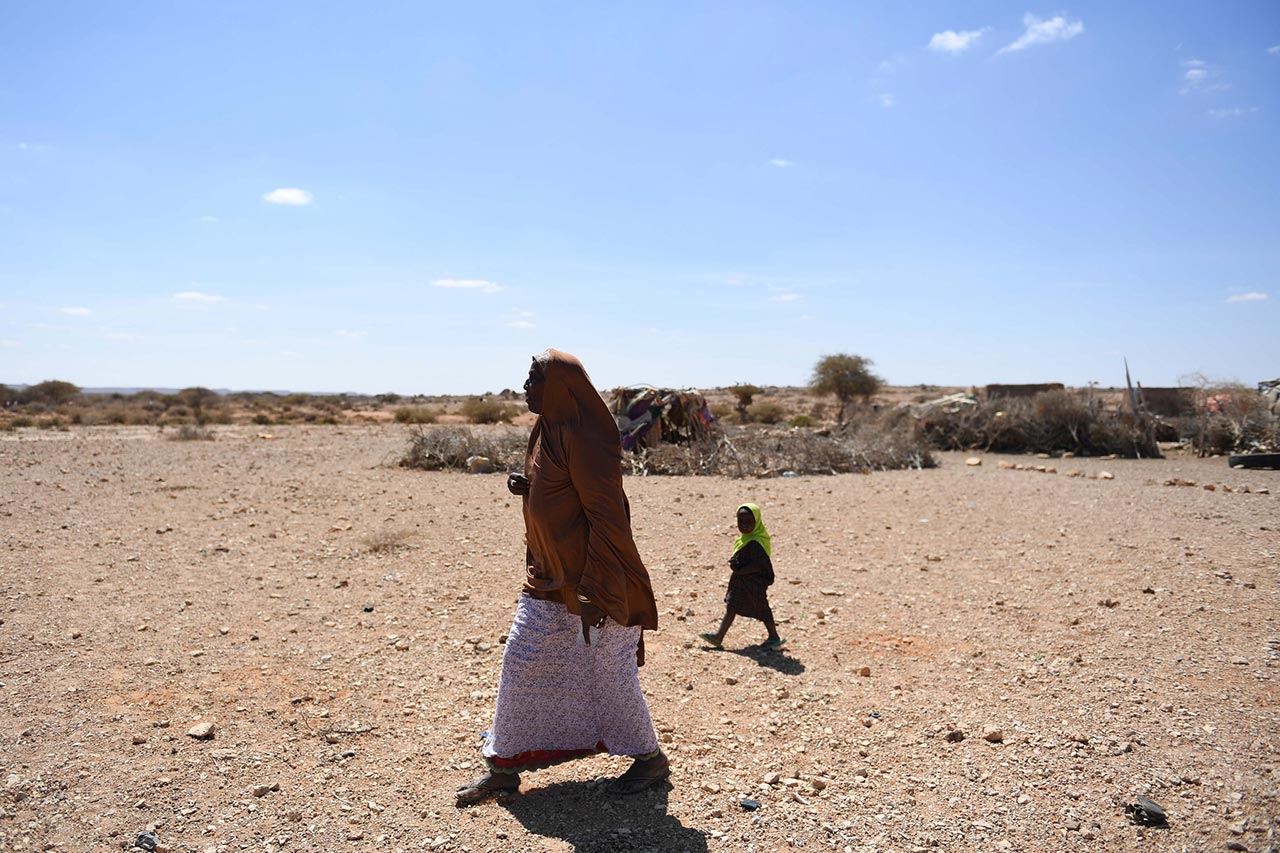 A woman walks in drought-hit Salaxley village, 15 kilometers south of Garowe in Puntland, on February 01 2017. Puntland is one of the regions hit by a severe drought. UN Photo / Ilyas Ahmed
A woman walks in drought-hit Salaxley village, 15 kilometers south of Garowe in Puntland, on February 01 2017. Puntland is one of the regions hit by a severe drought. UN Photo / Ilyas Ahmed
Across the Sahara
Once he had gathered enough money, Said took a minibus across Kenya and crossed into Sudan. That’s where he ran into what he calls a magafe — a person who looks for refugees on the street, tries to gain their trust, and promises to help them on their journey. The word means ‘one who never misses.’
In reality, the magafes sell refugees to human traffickers who lock them up, use them as slaves, and demand exorbitant fees for onward passage to the Mediterranean Sea.
“The magafe lures you, he gives you food and clothes and a place to sleep,” Said said. “He says it’s free to come, but actually he’s a smuggler. [At first] everything is free and you’re happy, but you don’t know what’s going to happen. When you get to Libya, they’ll make you pay.”
The magafe brought Said to his base in the Sudanese city of Khartoum, where he stayed for almost a month. It was a collection of shanty houses with mats to sleep on that, as time went on, was filled with more and more refugees, some coming from as far as Syria, Chad, and Afghanistan.
When the magafe had collected almost 200 refugees, he called his Libyan contacts and told them to bring their truck. The smugglers took Said and about 100 others across the Sudanese Sahara towards the Libyan border.
The refugees sat cramped together in the back of the old military truck. Some passed out from the fumes that rose from spilled petrol and open jerry cans. Some of the passengers “never woke up,” Said recalls.
“In Sudan, the Sahara is bigger and more dangerous than in Libya,” he said. “You hear nothing, there is nothing. The smugglers often stop the truck and call to ask for directions because it’s so easy to get lost.”
On his cellphone, Said showed a video made by another group of refugees on their way through the Sudanese desert. It showed a stalled pickup truck with the mummified corpse of a smuggler in the back. The dead man is still holding a stick he had used to fight off refugees who had tried to get inside, away from the sun. The truck is surrounded by dozens of sand-covered corpses, blackened and dried out.
“This is what happens when you get lost,” Said said.
According to his account, 27 people in his group died while crossing the desert. The traffickers forced him to dig shallow graves for his companions.
“The girls in the truck were crying at the sight of the dead peoples’ legs sticking out.”
After several days of driving, the truck stopped in the middle of the desert. Two smugglers got out and ordered the refugees to do the same. The truck turned around and drove away to pick up more people.
Meanwhile, the smugglers set up a tent and smoked shisha from a water pipe.
For days, the refugees had to sit in the sand, exposed to the desert’s blazing sun and its cold nights. They were only given half a cup of water and one piece of bread per day. At times, Sudanese locals came and handed out water and blankets.
“It was really cold at night,” Said recalled. “I had a small plastic bottle with water from which I would only drink at night, because during the day the water gets hot, which upsets your empty stomach.”
Said would put his clothes around his head and sit completely still. When you talk in those conditions, he said, “you waste a lot of energy and get sand in your mouth.”
“You also get beaten,” he added.
After waiting in the desert for five days, more pickups arrived to take them across the border. The traffickers, who sat in the cabs, used a well-practiced method to fill the beds of the trucks with as many people as possible.
“The girls lie down in the middle of the bed. The guys sit around them with their legs over the railing. On top of each guy sit up to two other guys and they hold on to each other” to not fall off.
“If the first guy goes, you go, so you have to hold on to him. If you fall out, the driver doesn’t stop and you die in the desert. You might also fall under the truck, and he will run you over.”
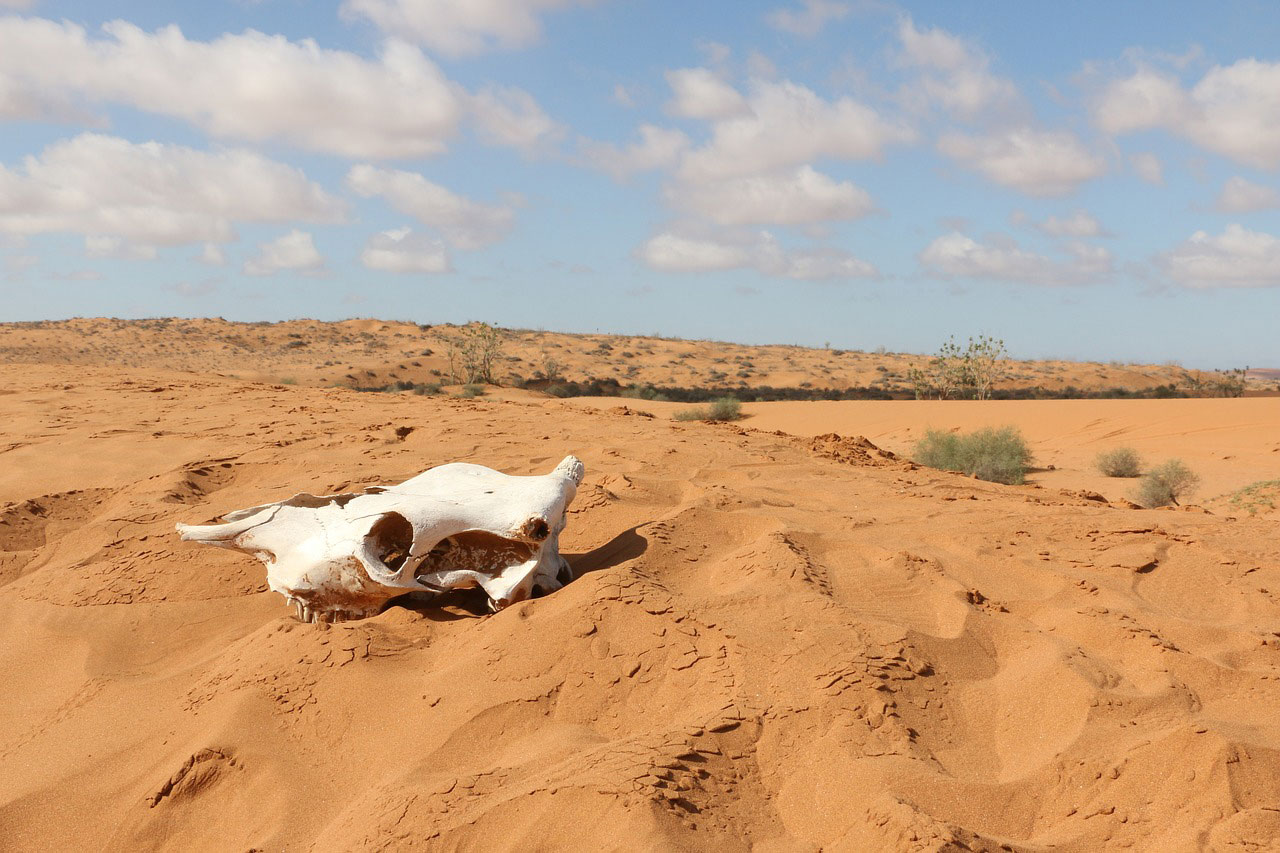 Migrants have to cross the Sahara desert in order to get to the Mediterranean Sea.
Migrants have to cross the Sahara desert in order to get to the Mediterranean Sea.
In the Slave Camp
The smugglers dropped the refugees off in Sabha, an oasis city in the middle of the Libyan desert. They were halfway to the sea.
“Sabha was ruled by Daesh [the Islamic State], and at that moment there was a lot of fighting. You would hear gunshots every night,” Said recalls.
He and about 600 others were put in a large hangar and forced to write down their names and the phone numbers of friends and relatives.
“If you don’t want to call your family, they take you by your leg, hang you upside-down, and beat you until you give them the numbers,” he said.
The smugglers were keeping the refugees hostage until they or their families paid their fees — and they were steep.
“At first, they said we had to pay $6,000, but later they lowered it to $3,000,” Said said. “They told us nobody could leave if we didn’t all pay. If you don’t pay, you’ll die there. And while you’re there, they make you work like a slave.”
While waiting for the money to trickle in, the captors made the refugees unload guns and dig trenches.
This is what happens to many refugees, says William Spindler, the UN Refugee Agency’s senior communications officer for North Africa and Yemen.
“A lot of refugees are brought to Libya and held there,” Spindler said. “The smugglers basically extort their clients. They keep them as prisoners and beat them up and force them to call or write their families.”
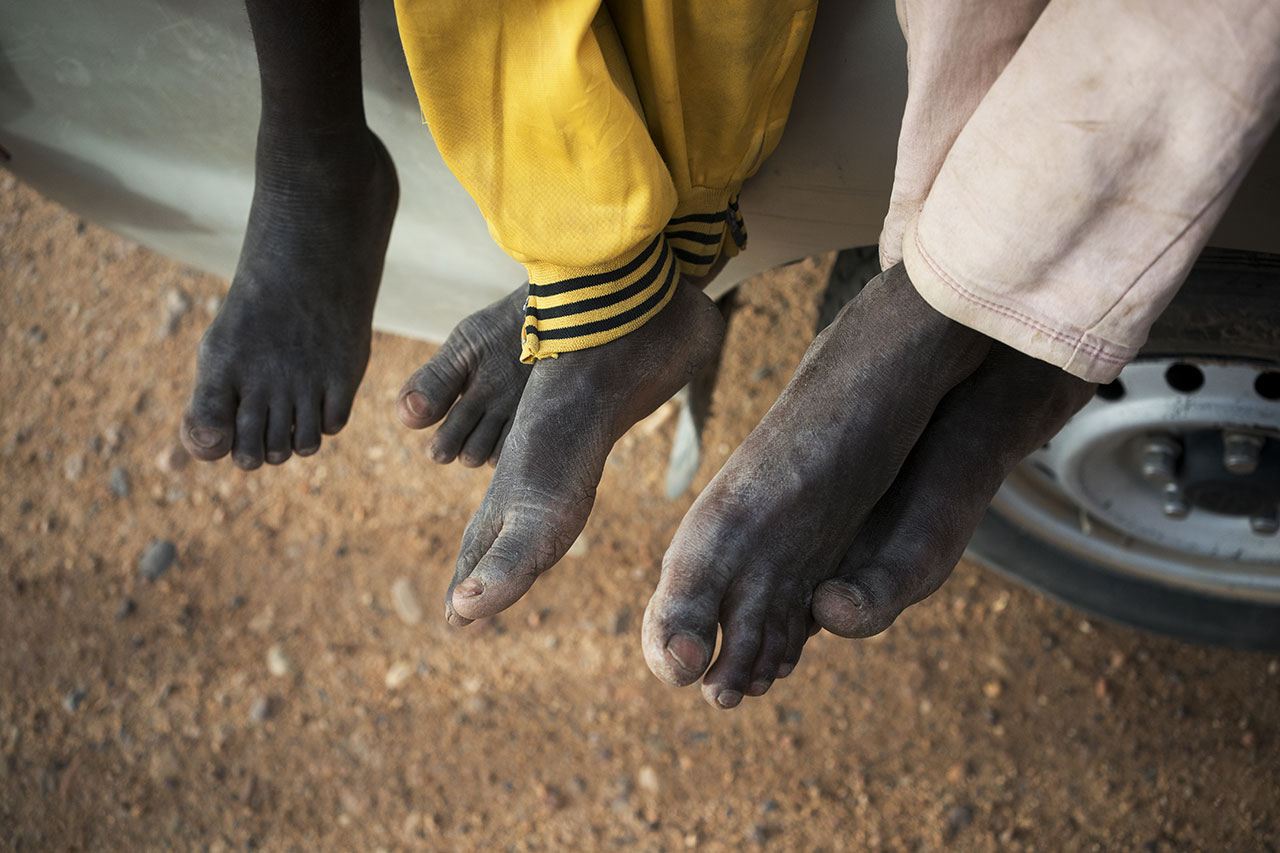 Feet of migrants heading towards Libya. Monday, June 4, 2018. (AP Photo/Jerome Delay)
Feet of migrants heading towards Libya. Monday, June 4, 2018. (AP Photo/Jerome Delay)
At the camp in Sabha, the smugglers tortured the refugees to get them to pay up.
“There was one Somali man who had been there for eight months,” Said said. “He was already finished, half-dead. They put electric wires on his testicles and told us that if we didn’t pay, we would end up like him.”
Once, three men tried to escape, climbing out of the building through a small air vent.
“One of them was driven over by a car after he jumped from the vent, and he died. When they caught the other two, they beat them. Then they separated them from the group and made them work.”
In the mornings, the smugglers gave their captives about 10 ounces of water for the day and threw pieces of bread into the crowd. “Whether you get some is up to you,” Said said.
There were no hygienic facilities or beds.
“They give you half a small bottle of water and that’s all the water you get for the entire day. When you need to pee or shit, you do it in front of them,” Said recalled. “There was no room to lie down, so we slept sitting with our knees to our chins.”
In the evenings, the refugees were told to huddle in groups of ten and given plain pasta to eat. Many fought to get as much as they could.
“If you want to survive, you grab the food. You don’t talk and you don’t spit. You try not to make the smugglers angry and you do what they tell you.”
For Said, the hardest moment was having to remain quiet while witnessing rape.
“At night, these people would chew khat and get drunk. There was one big guy, he was Chadian or Nigerian, with very dark skin,” he said. “At night he would open the big door and take one girl. The first night, he took an Eritrean girl. He just picked her up by the arm and carried her with him.”
On the second night, a friend of Said’s tried to stand up against the rapist.
“Mahad and I were sitting with our backs touching when the big guy picked up a Somali girl who was sitting next to us. The girl shouted, ‘Muslima, Muslima!’ but the guy didn’t care. Mahad tried to stop him and take the girl away from him. Then they beat all of us.”
Mahad’s attempt was brave, but in vain.
“He raped the Somali girl right in front of us. Like, he was doing it right here. Nobody could do anything.”
Talking about that night, Said’s voice grew quiet. He feels ashamed.
“For me, as a man, it’s … I couldn’t fight him. Understand me, I can’t go and fight him, but it’s really shameful for me that she’s a Somali girl being raped in front of me.”
The girl’s screams, he said, will stay with him for the rest of his life.
“The Eritreans, they don't scream. But the Somali girl, she did. The worst part is the screaming, because maybe you can forget seeing what happened, but the scream, you will remember it. Always!”
“She screamed out for help in Somali,” Said recalled with tears in his eyes. “But we didn’t have the heart. It may have been 300 of us men, and we did nothing.”
Every night, the same man would rape a different girl, marking them with cigarette burns so he wouldn’t go after the same one twice.
Gradually, the group’s living conditions deteriorated.
Since they were always kept together and had no way to clean up, nits and lice spread across the prisoners. Said still has scars on his hands from the bug bites.
“The bugs were everywhere. I saw some guys cut their penises apart from scratching where the bugs bit them,” he said.
The Christians were treated even worse.
“There were a lot of Christian Eritreans and some of them wore their crosses, which Daesh would rip off their necks. If they didn’t wear a cross, they would ask them what time the morning prayer is or how it goes, which the Christians don’t know.”
Once identified as Christians, “90 percent of the time, they kill the men and take the girls as sex slaves,” Said said.
But it’s not just Christians. According to a 2016 report by the International Organization for Migration, 71 percent of refugees who travel across the Mediterranean Sea or through the surrounding countries have experienced abuse, mostly in Libya.
To the Sea
The human traffickers fight each other for clients, who thus run the risk of having to pay for their passage twice. So many refugees try to pay the smugglers as late as possible.
“If you pay a smuggler and then there is another guy who shoots him and takes you, you have to pay again. That’s why it’s always better to pay late, even if they beat you,” Said said.
The hangar in Sabha where Said was being kept started to fill up as more refugees were brought in every day. At one point, it held over 600 people. One of the leaders, who called himself “Hadji Esmael,” announced that they no longer had to wait until everybody had paid. Those who had paid would be taken to Tripoli.
By way of celebration, Hadji Esmael slaughtered a goat and gave the refugees their first slice of meat since they had arrived.
“It was the best food we got when we were there,” Said said.
Until he got to Sabha, Said didn’t know that he would have to pay $3,000. The money he had on him didn’t come close. His only chance to leave the camp lay with his mother somehow being able to gather the unimaginably huge amount.
Desperate to leave, Said contacted her by calling his village's “tar,” a common village radiotelephone answered by an operator.
“My mother cried when she answered the phone,” Said said. “She asked if they beat me. I said that I’m okay, I am a man.”
Said’s mother called everyone who came to mind. Eventually Haxwo, the family acquaintance from Belgium, came up with the funds. The smugglers instructed that the money be transferred to a man in Sudan, who then informed the Libyans that the payment for Said had been made.
Along with others who had managed to make their payments, Said was taken from the base and once again packed into a truck. The refugees were hidden between layers of hay and told to keep quiet so other traffickers wouldn’t find them.
After driving for a day and a night, the truck arrived near Tripoli. The traffickers didn’t take their captives into the city, which was at that time wracked by civil war.
The smugglers took them to a big building that had been partially destroyed by the fighting.
“We had to lie down on our stomachs,” Said recalled. “We were only allowed to raise our heads when the food came. I think it was more than 500 of us.”
After five days, a caravan of cars came to take them to the Mediterranean Sea.
Two Trips Across
On the shore, the smugglers split the refugees into groups. They gave them four small boats and filled each one with as many refugees as possible. There was little room left for supplies.
Then they asked who could drive a boat and two men from Said’s group raised their hands. The smugglers showed the men how to steer but provided no navigational tools. They were simply told to “keep going straight.”
Families and children were let on first. The dinghy quickly filled and people started panicking. Afraid that they would be left behind, some pushed others aside to get in. Many had been waiting in Sabha and Tripoli for months.
As one of the few who knew how to swim, Said swam around the crowd and was pulled up by a Senegalese man who had volunteered to drive. He sat down in the dinghy and started contemplating the group’s chances.
According to the UNHCR, some 4,000 refugees drowned trying to cross to Europe just in 2015. The number rose to 5,000 by the following year. And by August 2018, according to statistics from the UN Refugee Agency, 11,700 refugees died or went missing in the Mediterranean.
Said may not have known these statistics at the time, but the odds were clear. It was either risking his life in the crossing or going back to hell.
“The moment you look out at the sea, you think, ‘If I am going to die in this water, that’s better than dying in Libya,’” he said.
A smuggler instructed the group to call the coast guard as soon as they got within reach of their radio signal.
“He gave us a big phone with an antenna and a number to call. He told us, ‘when you are on the ocean for maybe a night, you call the number and the big ship will come to save you.’”
After waiting for the right current, the dinghy started heading north. Soon many in the group became seasick. Everyone was “either crying, praying or completely turned into themselves, like me,” said Said.
“People started throwing up and babies started crying. People were crammed together, over 100 per boat. They were sitting on each other’s legs and some were screaming from the pain.”
After three days at sea without any provisions, they encountered a bad sign: Tunisian coastguards passed by and threw them some food. A little later, some fishermen stopped and shouted that the currents had taken them west to Tunisia instead of North towards Italy.
“Everybody became demoralized, we were down. We had been lost at sea with nothing to eat. Mentally your mind is finished, you can’t think of anything. You want to make it or die. You don’t want to go back to Libya. You’d rather be dead, because you know what they would do to you there. Libya is hell.”
Lost and exhausted, they tried to get back to where they came from. Two of the four boats made it back to where they had started. The other two were lost at sea. Back on the beach, they came across a Kurd who knew Hadji Esmael.
He gave Said’s group a wider boat, an extra motor, and added more refugees. He was accompanied by four guards carrying automatic rifles. They started threatening the already demoralized refugees.
“He told us, ‘If you come back, you have to pay again,’ Said said. “The Senegalese man who had steered before sat down in shame and someone else volunteered to drive.”
Off they went again, in a bigger boat with an extra motor, more people, and increasingly desperate.
 Photo released by the Libyan Coast Guard on June 24, 2018 shows migrants on a ship intercepted offshore near the town of Gohneima, east of the capital, Tripoli. There were four boats, boarding 490 African migrants including 75 women and 21 children, Spokesman Ayoub Gassim said. (Libyan Coast Guard via AP)
Photo released by the Libyan Coast Guard on June 24, 2018 shows migrants on a ship intercepted offshore near the town of Gohneima, east of the capital, Tripoli. There were four boats, boarding 490 African migrants including 75 women and 21 children, Spokesman Ayoub Gassim said. (Libyan Coast Guard via AP)
A Norwegian Rescue
The exposure to the waves, the wind, and the salt water had exhausted and weakened the group.
“When you’re sitting in the dinghy, the water hits you from behind and you have to vomit from seasickness,” Said said. “At the same time, the boat is filling with water. We would cup our hands to take the water out of the boat. The salt hurts you everywhere and after a few days on the sea, you look like someone else. I don’t know how I survived, but for seven days I just drank sea water.”
Due to his exhaustion, Said “couldn’t tell day from night.” He thinks that after about three days they ended up near Malta. There the group was picked up by a Norwegian ship.
“We saw a big ship,” Said said. “We thought it was a warship but it was the Norwegian coast guard. They started throwing lifebuoys and jackets and a big rope.”
The personnel on the ship fed the refugees and gave them water and blankets.
“I was struck by what they told us: ‘you are safe, we’ll take care of you. Sleep well and rest up.’ After Libya, I never expected anyone to care about us.”
The ship took them to Lampedusa and then to Sicily.
The Norwegian government has one ship, the Siem Pilot, which carries out such rescue operations near the Libyan coast. It is manned by Norwegian Navy and justice department personnel.
According to Axel Due, communications adviser of Norway’s National Crime Investigation Service, the dinghies were probably still closer to the Libyan coast than to Malta.
“The Siem Pilot only stops near Lampedusa sometimes,” Due said. “Lampedusa’s port is too small for the boat to embark, so they only stop there to drop off very sick or pregnant people who need immediate attention.”
Due confirms that the ship would have taken the refugees to Sicily.
“If Someone Gives You Water, Give Them Milk”
Said stayed in Sicily for two and a half weeks. One day, he was walking to a food drive at a church with a Somali friend he knew from the slave camp in Sabha. They came across an older Somali man who had been living in Sicily for years.
“This man said he could see we are sick and that we could stay at his house in Sicily,” Said said. “We automatically trusted him because he was Somali. He said that if we gave him 800 euros, he would take us to Germany.”
Said knew that his acquaintance in Belgium, Haxwo, didn’t have any money left. His friend, however, knew someone in England who could send them the money.
But it was a cruel deception.
“Once we gave the money to the man, we never saw him again,” Said said.
A Somali woman who lived next door gave Said and Ahmed 100 euros each so they could take a bus to Rome and head onward to Belgium and Germany, respectively. Said wanted to go to Belgium to be with Haxwo and because the asylum procedure there only takes a few months. In other countries it can last for years.
He and Ahmed parted ways in Germany, where Said traveled through Nuremberg, Munich, and Frankfurt. From there he took a bus to Brussels.
At five in the morning on November 22, 2015 — ten grueling months after leaving Somalia — Said stepped out of the bus in Brussels and asked two men how to get to the immigration office.
“I remember the date because it’s written in my ID,” Said said.
After spending some time in an immigration center and after being interviewed, Said had to wait for two months to get the verdict.
In April 2016, he learned that he had been granted a five-year refugee visa.
“They said my appeal was positive because I was a refugee and they gave me a permit to stay for five years. I called my ‘sister’ Haxwo to tell her the news and went to the city where she lived.”
When Said spoke about the reception he received in Belgium, his eyes filled with tears.
“I’m crying because I’m so grateful. My mom always told me that if someone gives you water, you give them milk. I want to get an education and work here, I want to learn the values and have a family so my son can go to school here,” he said.
Said hopes that one day he can go back and tell his friends and family about the West and how different it is from what they are told by al-Shabab.
“If my village is ever liberated, I want to go back and tell my mother, if she is still alive, what the Western people are like.”
With additional reporting by Adrien Cardon.
